Похожие презентации:
Principles of Marketing
1. Principles of Marketing
10Principles of Marketing
Pricing Products:
Understanding and Capturing
Customer Value
2. What Is Price?
Price is the amount of money charged for aproduct or service. It is the sum of all the
values that consumers give up in order to
gain the benefits of having or using a
product or service.
Price is the only element in the marketing mix
that produces revenue; all other elements
represent costs
10-4
3. Factors to Consider When Setting Prices
Customer Perception of ValueEffective customer-oriented pricing involves
understanding how much value consumers
place on the benefits they receive from the
product and setting a price that captures that
value
10-5
4. Factors to Consider When Setting Prices
Customer Perception of ValueValue-based pricing uses the buyers’
perceptions of value, not the seller’s cost,
as the key to pricing. Price is considered
before the marketing program is set.
Value-based pricing is customer driven
Cost-based pricing is product driven
10-6
5. Factors to Consider When Setting Prices
Customer Perception of ValueValue-based pricing
Good-value pricing
Value-added pricing
10-7
6. Factors to Consider When Setting Prices
Customer Perception of ValueGood-value pricing offers the right
combination of quality and good service to
fair price
Existing brands are being redesigned to offer
more quality for a given price or the same
quality for less price
10-8
7. Factors to Consider When Setting Prices
Customer Perception of ValueEveryday low pricing (EDLP) involves charging a
constant everyday low price with few or no
temporary price discounts
High-low pricing involves charging higher prices on
an everyday basis but running frequent promotion
to lower prices temporarily on selected items
10-9
8. Factors to Consider When Setting Prices
Customer Perception of ValueValue-added pricing attaches value-added features
and services to differentiate offers, support higher
prices, and build pricing power
Pricing power is the ability to escape price
competition and to justify higher prices and margins
without losing market share
10-10
9. Factors to Consider When Setting Prices
Company and Product CostsCost-based pricing involves setting prices
based on the costs for producing,
distributing, and selling the product plus a
fair rate of return for its effort and risk
10-11
10. Factors to Consider When Setting Prices
Company and Product CostsTypes of costs
Fixed costs
Variable costs
Total costs
10-12
11. Factors to Consider When Setting Prices
Company and Product CostsFixed costs are the costs that do not vary with
production or sales level
Rent
Heat
Interest
Executive salaries
10-13
12. Factors to Consider When Setting Prices
Company and Product CostsVariable costs are the costs that vary with the
level of production
Packaging
Raw materials
10-14
13. Factors to Consider When Setting Prices
Company and Product CostsTotal costs are the sum of the fixed and
variable costs for any given level of
production
10-15
14. Factors to Consider When Setting Prices
Company and Product CostsAverage cost is the cost associated with
a given level of output
10-16
15. Factors to Consider When Setting Prices
Company and Product CostsExperience or learning curve is when the
average cost falls as production increases
because fixed costs are spread over more
units
10-17
16. Factors to Consider When Setting Prices
Company and Product CostsCost-based pricing adds a standard markup
to the cost of the product
markup price= unit cost
(1-desired rate of return)
10-18
17. Factors to Consider When Setting Prices
Break-Even Analysis and Target Profit PricingBreak-even pricing is the price at which total
costs are equal to total revenue and there is
no profit
Target profit pricing is the price at which the
firm will break even or make the profit it’s
seeking
10-19
18. Factors to Consider When Setting Prices
Break-Even Analysis and Target Profit Pricingbreak-even= fixed cost
volume
(price-variable cost)
10-20
19. Factors to Consider When Setting Prices
Other Internal and External ConsiderationsAffecting Price Decisions
Customer perceptions of value set the upper
limit for prices, and costs set the lower limit
Companies must consider internal and external
factors when setting prices
10-21
20. Factors to Consider When Setting Prices
Other Internal and External ConsiderationsAffecting Price Decisions
Internal factors
Marketing strategies
Objectives
Marketing mix
External factors
Market demand
Competitor’s strategies and prices
10-22
21. Factors to Consider When Setting Prices
Other Internal and External ConsiderationsAffecting Price Decisions
Pricing objectives include:
Survival
Profit maximization
Market share leadership
Customer retention and relationship building
Attracting new customers
Opposing competitive threats
Increasing product excitement
10-23
22. Factors to Consider When Setting Prices
Other Internal and External ConsiderationsAffecting Price Decisions
Target costing starts with an ideal selling
price based on consumer value
considerations and then targets costs that
will ensure that the price is met
10-24
23. Factors to Consider When Setting Prices
Other Internal and External ConsiderationsAffecting Price Decisions
Non-price strategies differentiate the
marketing offer to make it worth a higher
price
10-25
24. Factors to Consider When Setting Prices
Other Internal and External ConsiderationsAffecting Price Decisions
Organizational considerations include:
Who should set the price
Who can influence the prices
10-26
25. Factors to Consider When Setting Prices
Other Internal and External ConsiderationsAffecting Price Decisions
The Market and Demand
Before setting prices, the marketer must
understand the relationship between price
and demand for its products
10-27
26. Factors to Consider When Setting Prices
Other Internal and External ConsiderationsAffecting Price Decisions
Types of markets
Pure competition
Monopolistic competition
Oligopolistic competition
Pure monopoly
10-28
27. Factors to Consider When Setting Prices
Other Internal and External ConsiderationsAffecting Price Decisions
Pure competition is a market with few many buyers
and sellers trading uniform commodities where no
single buyer or seller has much effect on market
price
Monopolistic competition is a market with many
buyers and sellers who trade over a range of prices
rather than a single market price with differentiated
offers.
10-29
28. Factors to Consider When Setting Prices
Other Internal and External ConsiderationsAffecting Price Decisions
Oligopolistic competition is a market with few
sellers because it is difficult for sellers to enter who
are highly sensitive to each other’s pricing and
marketing strategies
Pure monopoly is a market with only one seller. In a
regulated monopoly, the government permits a
price that will yield a fair return. In a non-regulated
monopoly, companies are free to set a market
price.
10-30
29. Factors to Consider When Setting Prices
Other Internal and External ConsiderationsAffecting Price Decisions
The demand curve shows the number of units the
market will buy in a given period at different prices
Normally, demand and price are inversely related
Higher price = lower demand
For prestige (luxury) goods, higher price can equal
higher demand when consumers perceive higher
prices as higher quality
10-31
30. Factors to Consider When Setting Prices
Other Internal and External ConsiderationsAffecting Price Decisions
Price elasticity of demand illustrates the response of demand to
a change in price
Inelastic demand occurs when demand hardly changes when there
is a small change in price
Elastic demand occurs when demand changes greatly for a small
change in price
price elasticity of demand= % change in quantity demand
% change in price
10-32
31. Factors to Consider When Setting Prices
Other Internal and External ConsiderationsAffecting Price Decisions
Factors affecting price elasticity of demand
Unique product
Quality
Prestige
Substitute products
Cost relative to income
10-33
32. Factors to Consider When Setting Prices
Other Internal and External ConsiderationsAffecting Price Decisions
Competition strategies and prices
Factors to consider
Comparison of offering in terms of customer value
Strength of competitors
Competition pricing strategies
Customer price sensitivity
10-34
33. Chapter Eleven
Pricing Strategies34. New-Product Pricing Strategies
Pricing StrategiesMarket-skimming pricing
Market-penetration pricing
35. New-Product Pricing Strategies
Market-skimming pricing is a strategy with highinitial prices to “skim” revenue layers from the
market
Product quality and image must support the
price
Buyers must want the product at the price
Costs of producing the product in small volume
should not cancel the advantage of higher prices
Competitors should not be able to enter the
market easily
36. New-Product Pricing Strategies
Pricing StrategiesMarket-penetration pricing sets a low initial
price in order to penetrate the market
quickly and deeply to attract a large
number of buyers quickly to gain market
share
Price sensitive market
Inverse relationship of production and
distribution cost to sales growth
Low prices must keep competition out of
the market
37. Pricing Strategies
Productline pricing
Optionalproduct
pricing
By-product
pricing
Captiveproduct
pricing
Product
bundle
pricing
38. Product Mix Pricing Strategies
Pricing StrategiesProduct line pricing takes into account the
cost differences between products in the
line, customer evaluation of their features,
and competitors’ prices
Optional product pricing takes into account
optional or accessory products along with
the main product
39. Product Mix Pricing Strategies
Pricing StrategiesCaptive-product pricing involves products that
must be used along with the main product
Two-part pricing involves breaking the
price into:
Fixed fee
Variable usage fee
40. Price Mix Pricing Strategies
Pricing StrategiesBy-product pricing refers to products with little
or no value produced as a result of the main
product. Producers will seek little or no profit
other than the cost to cover storage and
delivery.
41. Price Mix Pricing Strategies
Pricing StrategiesProduct bundle pricing combines several
products at a reduced price
42. Price-Adjustment Strategies
Discount andallowance
pricing
Psychological
pricing
Geographic
pricing
Segmented
pricing
Promotional
pricing
Dynamic
pricing
Internationa
l pricing
43. Price-Adjustment Strategies
Pricing StrategiesDiscount and allowance pricing reduces
prices to reward customer responses such
as paying early or promoting the product
Discounts
Allowances
44. Price-Adjustment Strategies
Pricing StrategiesSegmented pricing is used when a company
sells a product at two or more prices even
though the difference is not based on cost
45. Price-Adjustment Strategies
Segmented PricingTo be effective:
Market must be segmentable
Segments must show different degrees
of demand
Watching the market cannot exceed the
extra revenue obtained from the price
difference
Must be legal
46. Price-Adjustment Strategies
Pricing StrategiesPsychological pricing occurs when sellers
consider the psychology of prices and not
simply the economics
Reference prices are prices that buyers
carry in their minds and refer to when
looking at a given product
Noting current prices
Remembering past prices
Assessing the buying situations
47. Price-Adjustment Strategies
Pricing StrategiesPromotional pricing is when prices are
temporarily priced below list price or cost to
increase demand
Loss leaders
Special event pricing
Cash rebates
Low-interest financing
Longer warrantees
Free maintenance
48. Price-Adjustment Strategies
Pricing StrategiesRisks of promotional pricing
Used too frequently, and copies by
competitors can create “deal-prone”
customers who will wait for promotions
and avoid buying at regular price
Creates price wars
49. Price-Adjustment Strategies
Pricing StrategiesGeographical pricing is used for customers in
different parts of the country or the world
FOB pricing
Uniformed-delivery pricing
Zone pricing
Basing-point pricing
Freight-absorption pricing
50. Price-Adjustment Strategies
Pricing StrategiesFOB (free on board) pricing means that
the goods are delivered to the carrier and
the title and responsibility passes to the
customer
Uniformed delivery pricing means the
company charges the same price plus
freight to all customers, regardless of
location
51. Price-Adjustment Strategies
Pricing StrategiesZone pricing means that the company sets
up two or more zones where customers
within a given zone pay a single total price
Basing point pricing means that a seller
selects a given city as a “basing point” and
charges all customers the freight cost
associated from that city to the customer
location, regardless of the city from which
the goods are actually shipped
52. Price-Adjustment Strategies
Pricing StrategiesFreight absorption pricing means the
seller absorbs all or part of the actual freight
charge as an incentive to attract business in
competitive markets
53. Price-Adjustment Strategies
Pricing StrategiesDynamic pricing is when prices are
adjusted continually to meet the
characteristics and needs of the
individual customer and situations
54. Price-Adjustment Strategies
Pricing StrategiesInternational pricing is when prices are set in
a specific country based on country-specific
factors
Economic conditions
Competitive conditions
Laws and regulations
Infrastructure
Company marketing objective
55. Price Changes
Initiating Pricing ChangesPrice cuts
Price increases
56. Price Changes
Initiating Pricing ChangesPrice cuts occur due to:
• Excess capacity
• Increased market share
Price increase from:
• Cost inflation
• Increased demand
• Lack of supply
57. Price Changes
Buyer Reactions to Pricing ChangesPrice
increases
• Product is “hot”
• Company greed
Price cuts
• New models will
be available
• Models are not
selling well
• Quality issues
58. Price Changes
Responding to Price ChangesQuestions
Why did the competitor change the price?
Is the price cut permanent or temporary?
What is the effect on market share and
profits?
Will competitors respond?
59. Price Changes
Responding to Price ChangesSolutions
Reduce price to match competition
Maintain price but raise the perceived
value through communications
Improve quality and increase price
Launch a lower-price “fighting” brand




















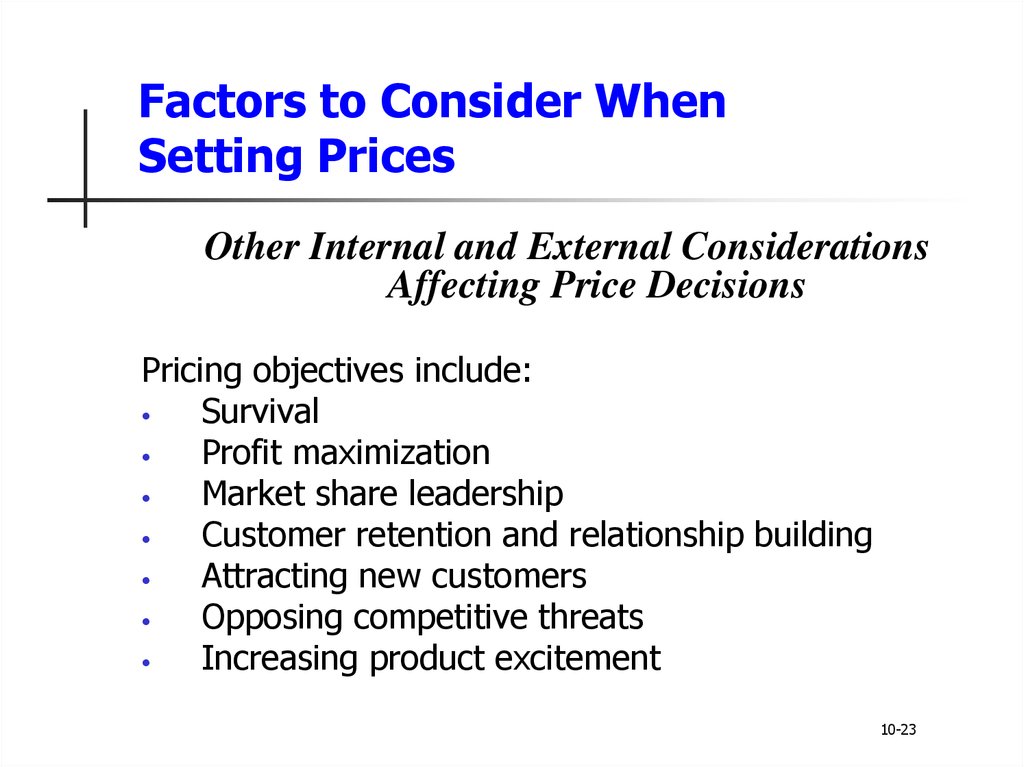
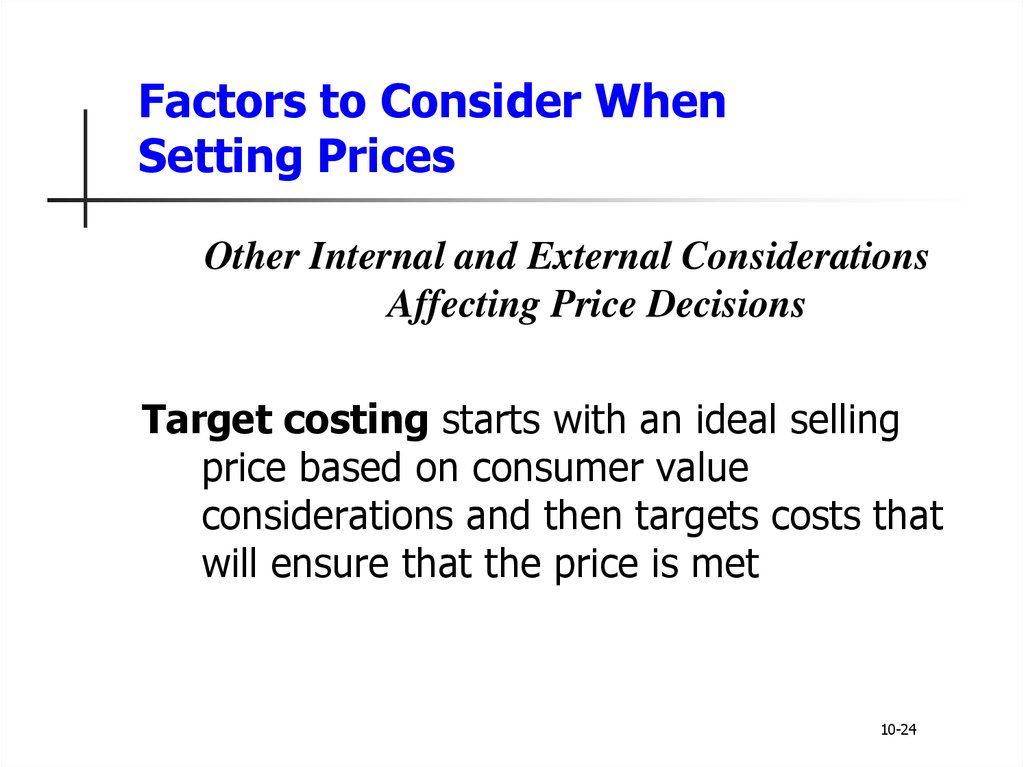

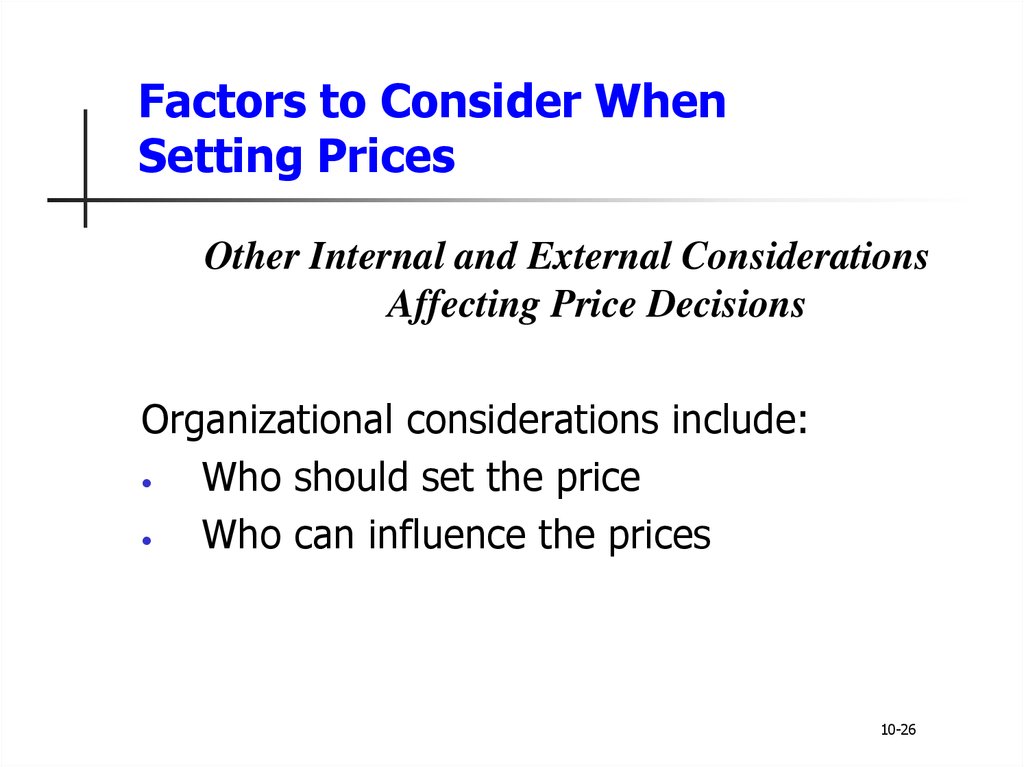


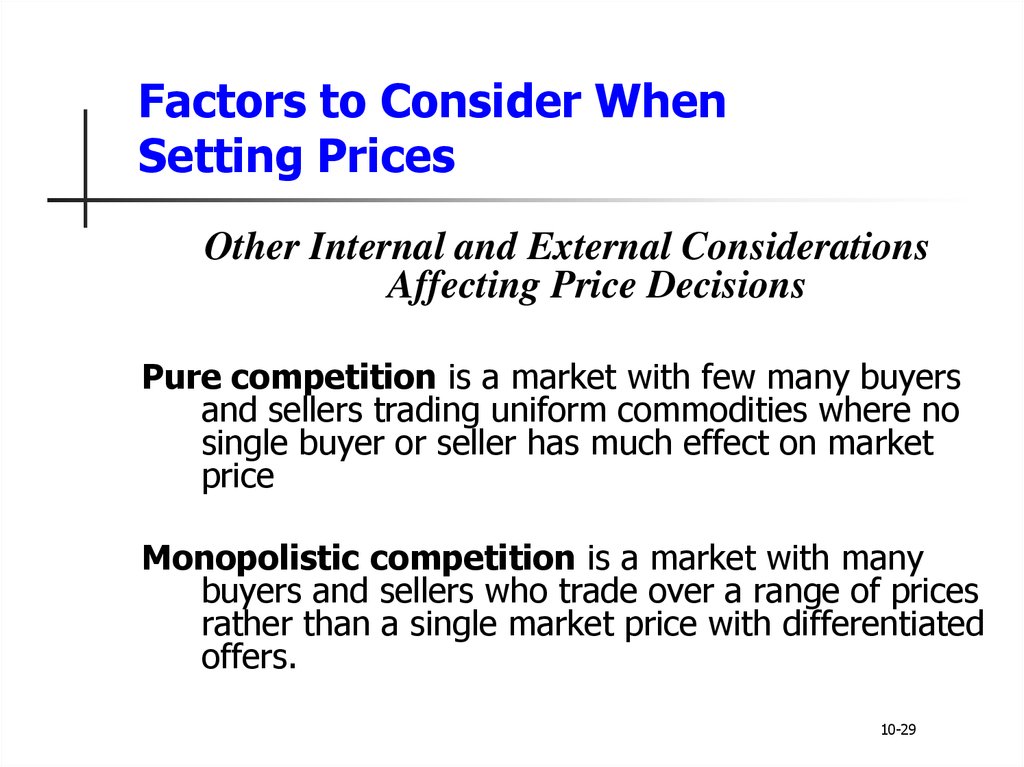
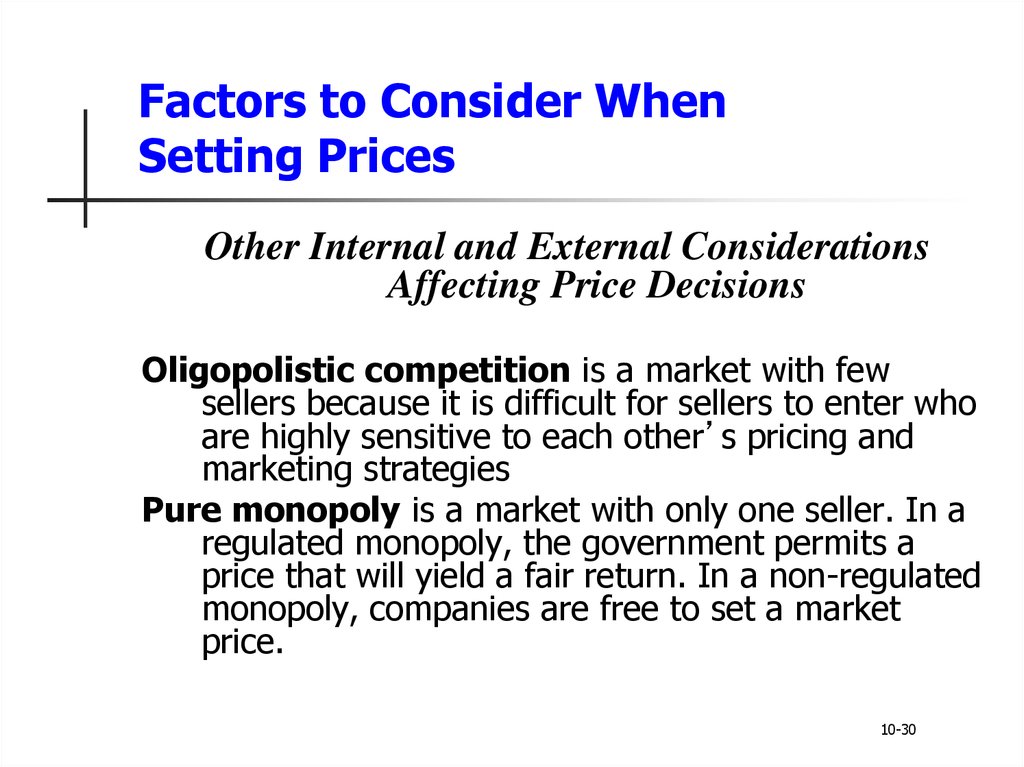
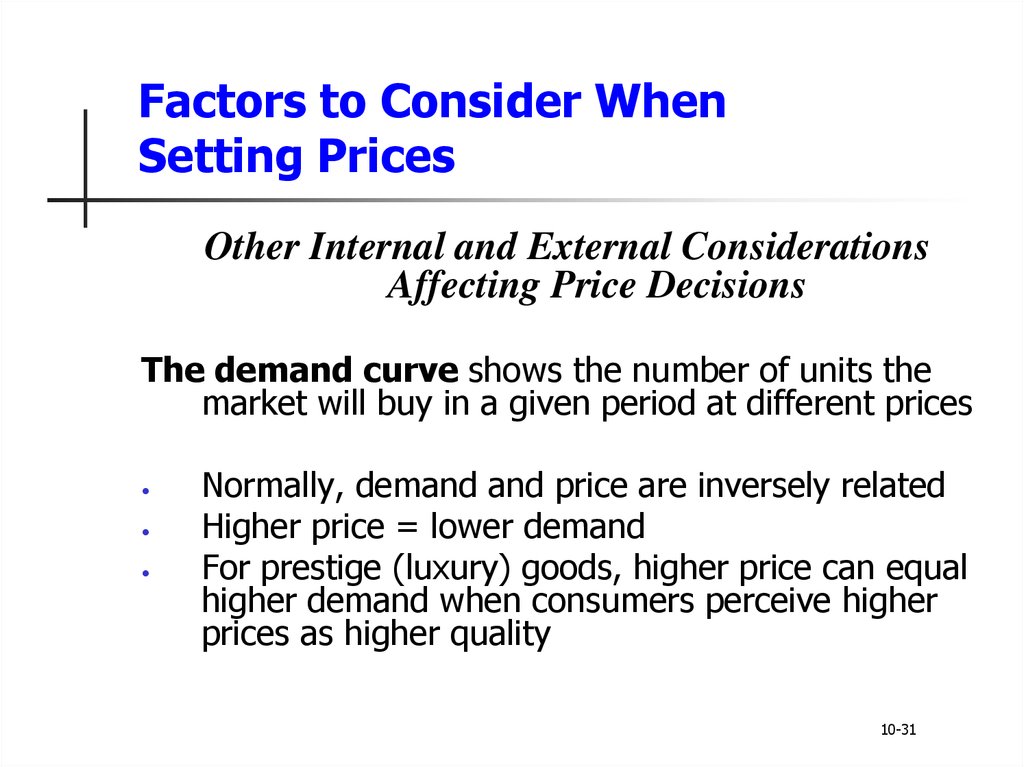
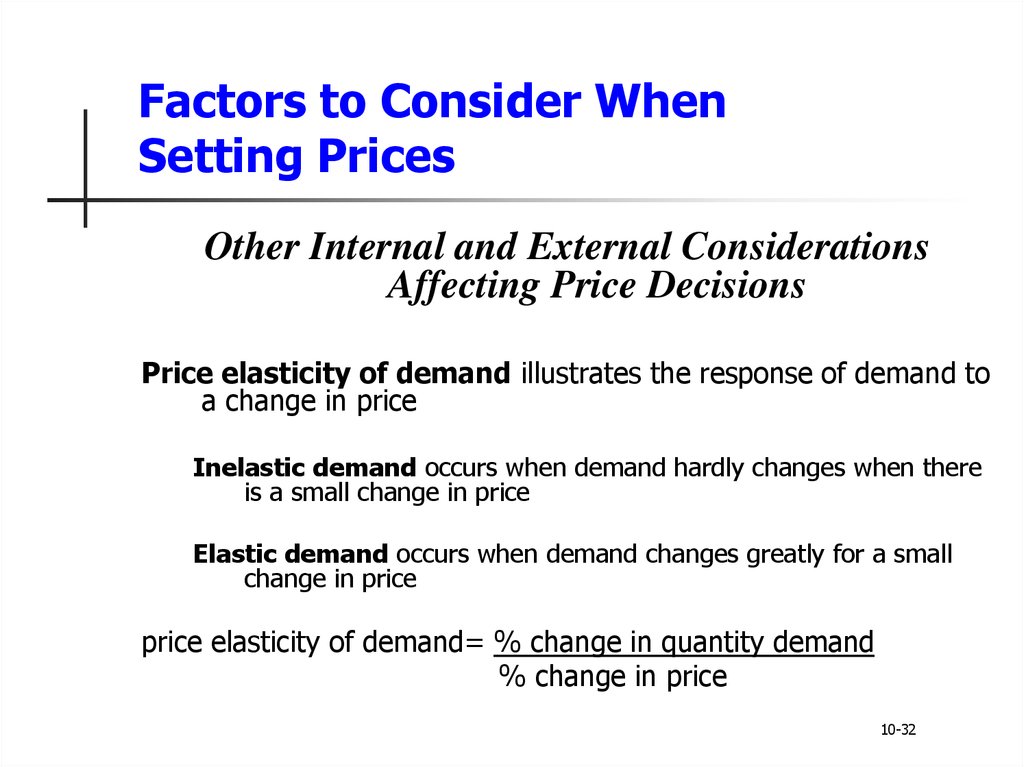

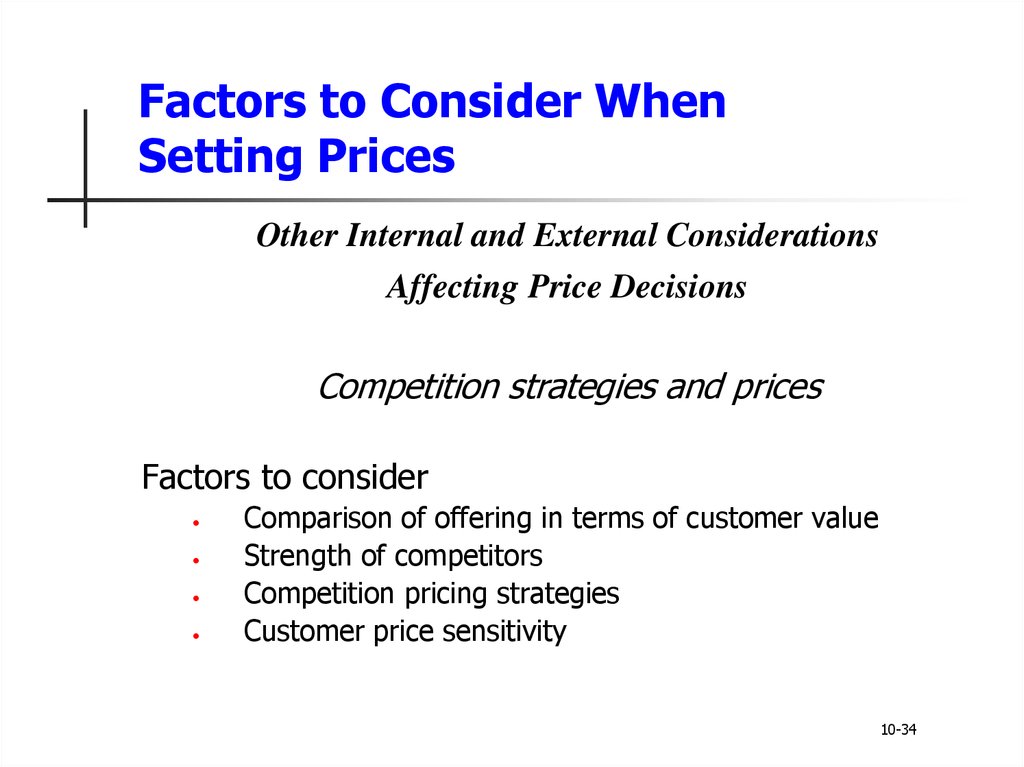
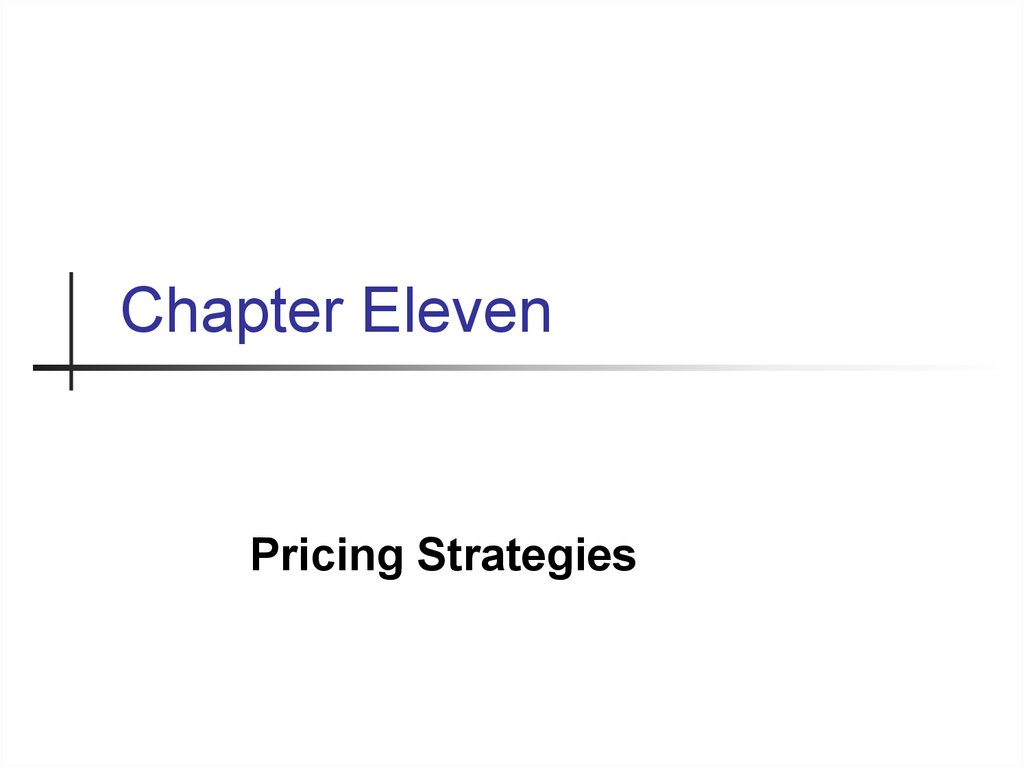
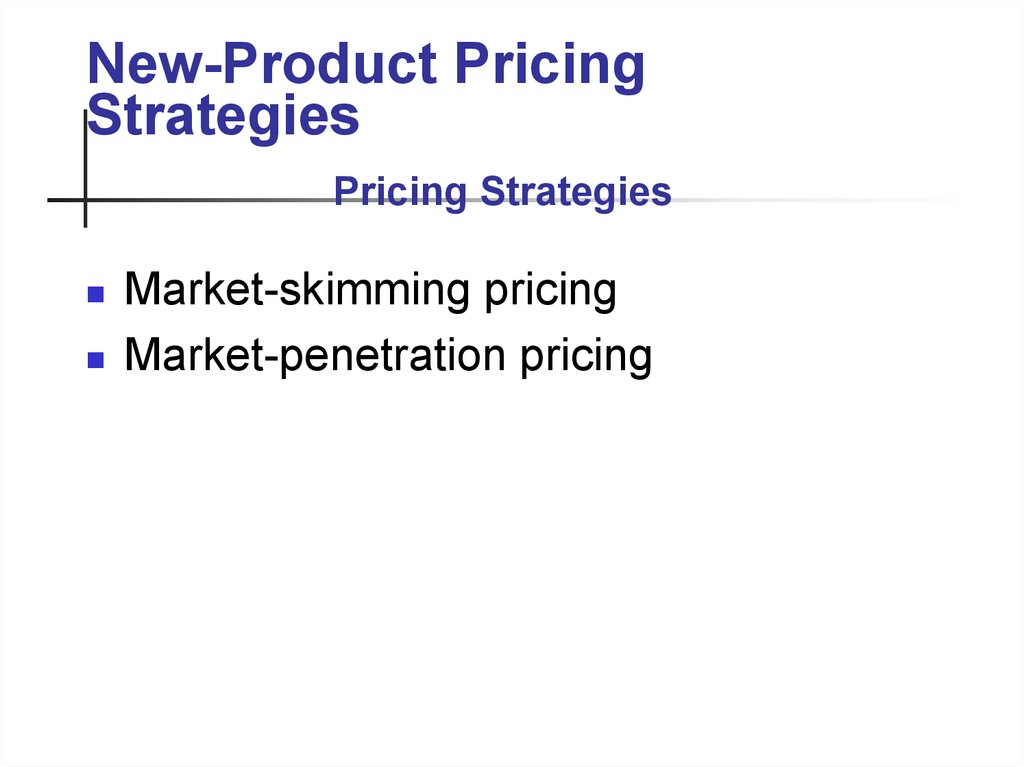
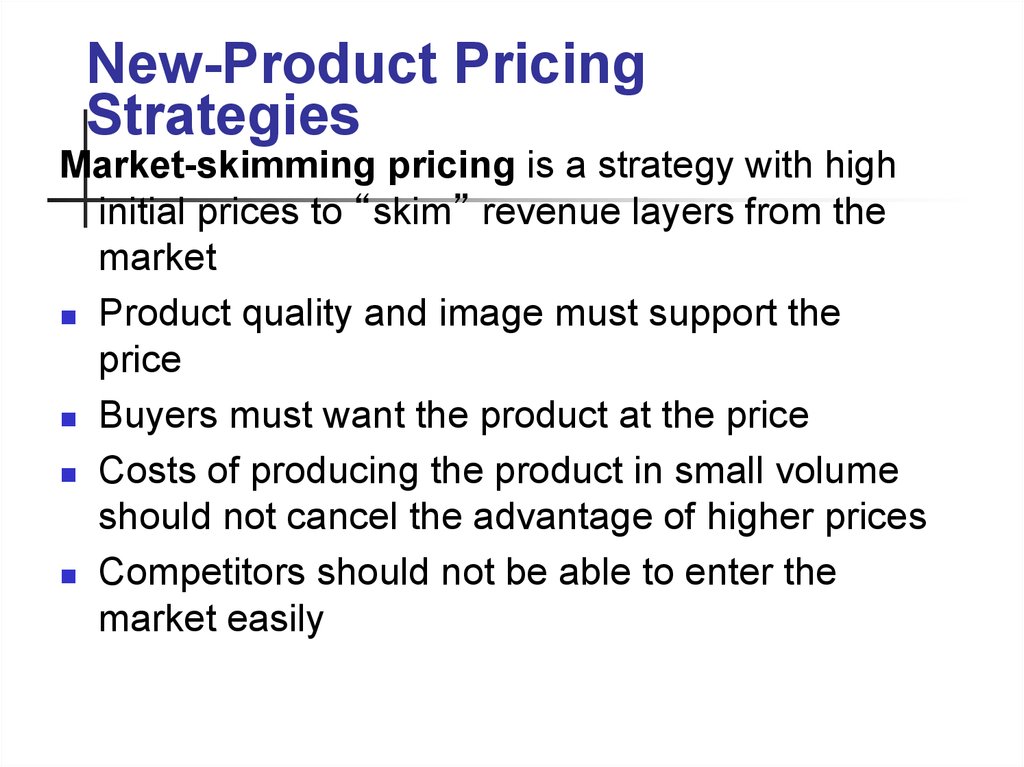
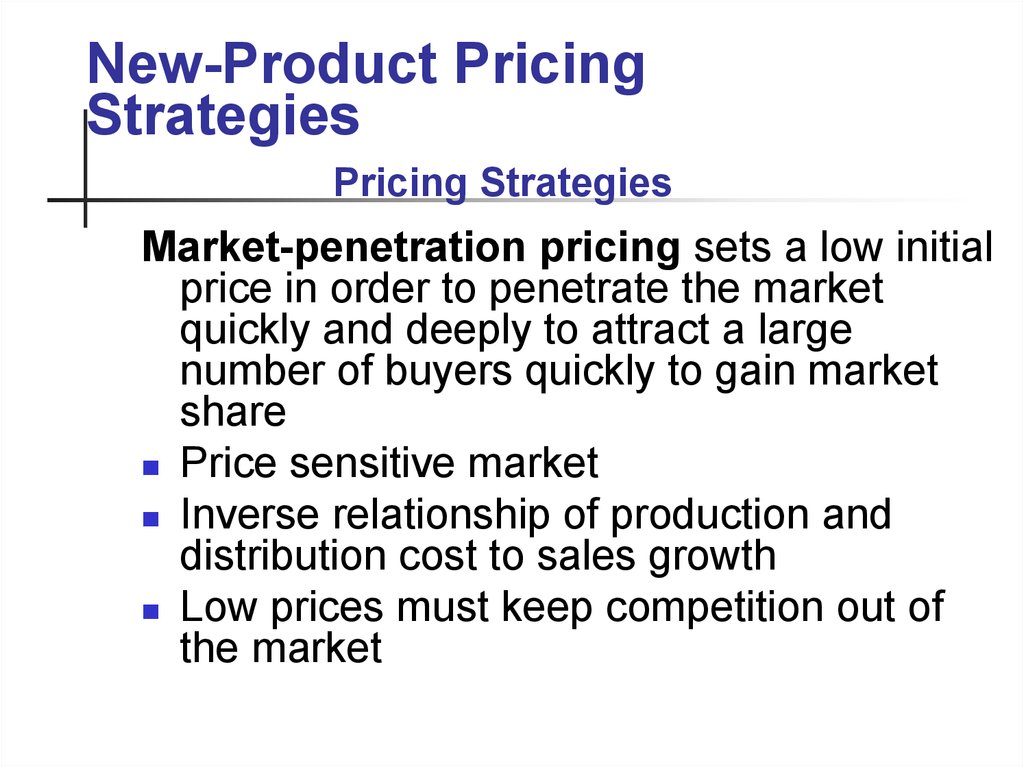
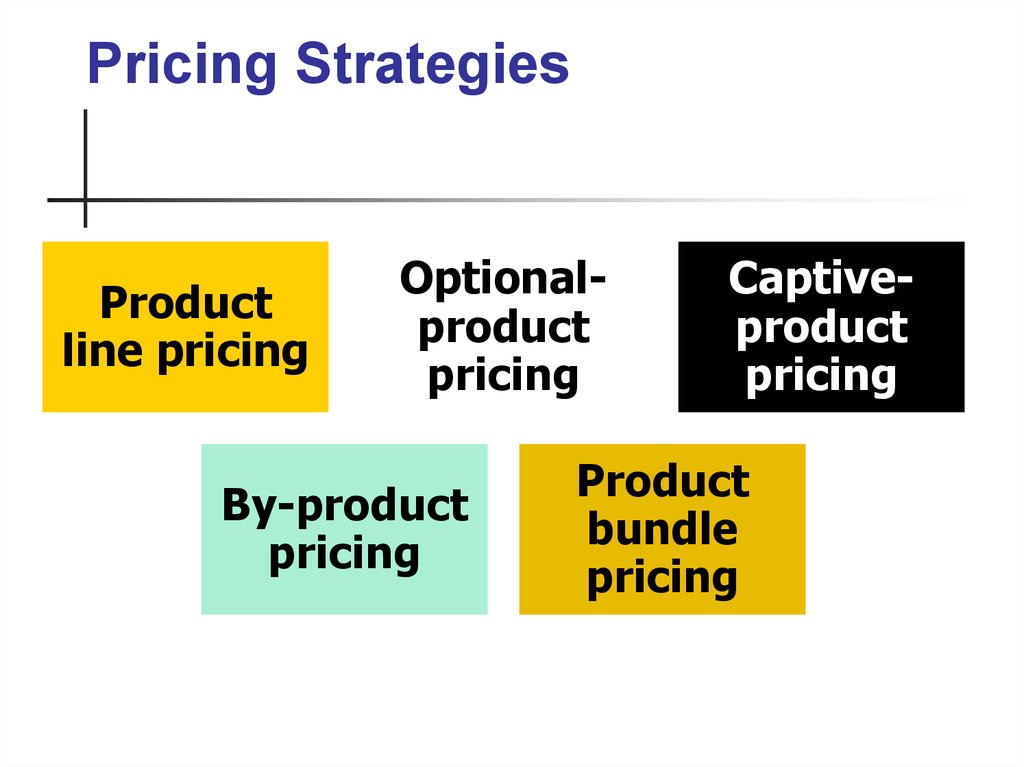
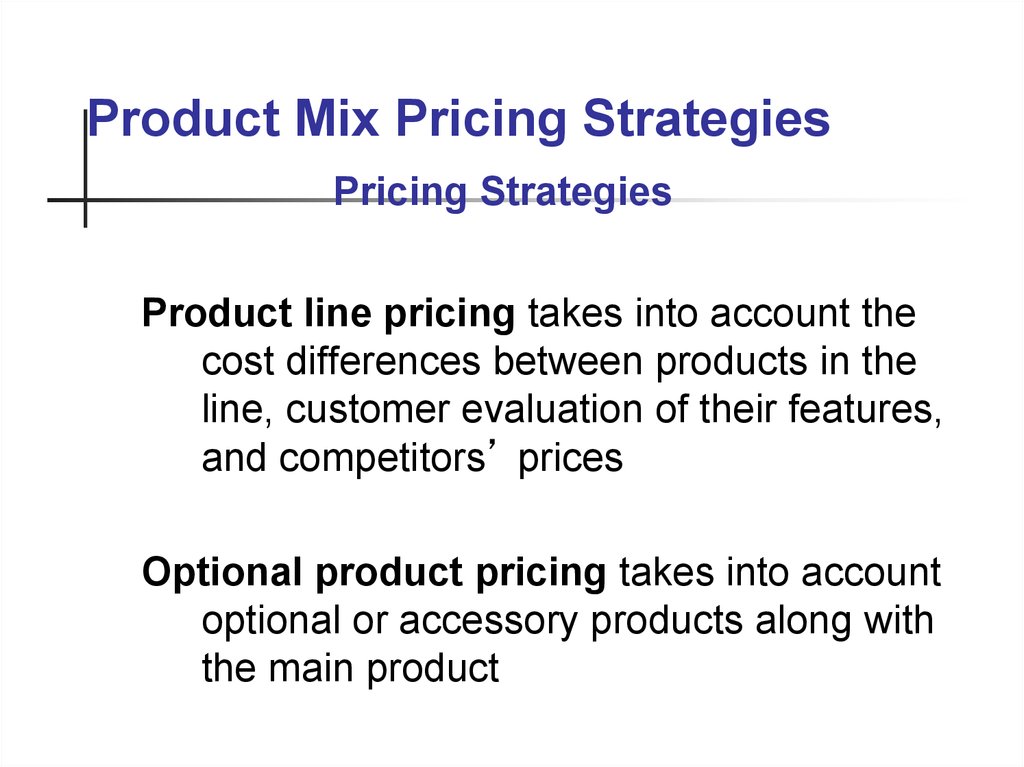
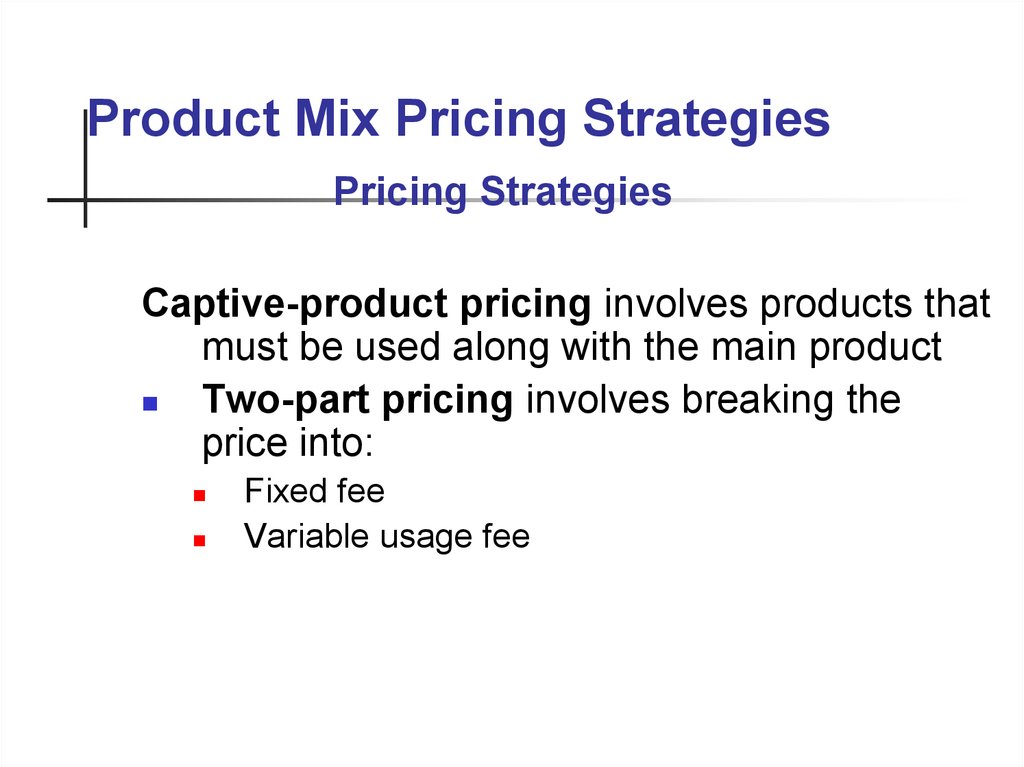

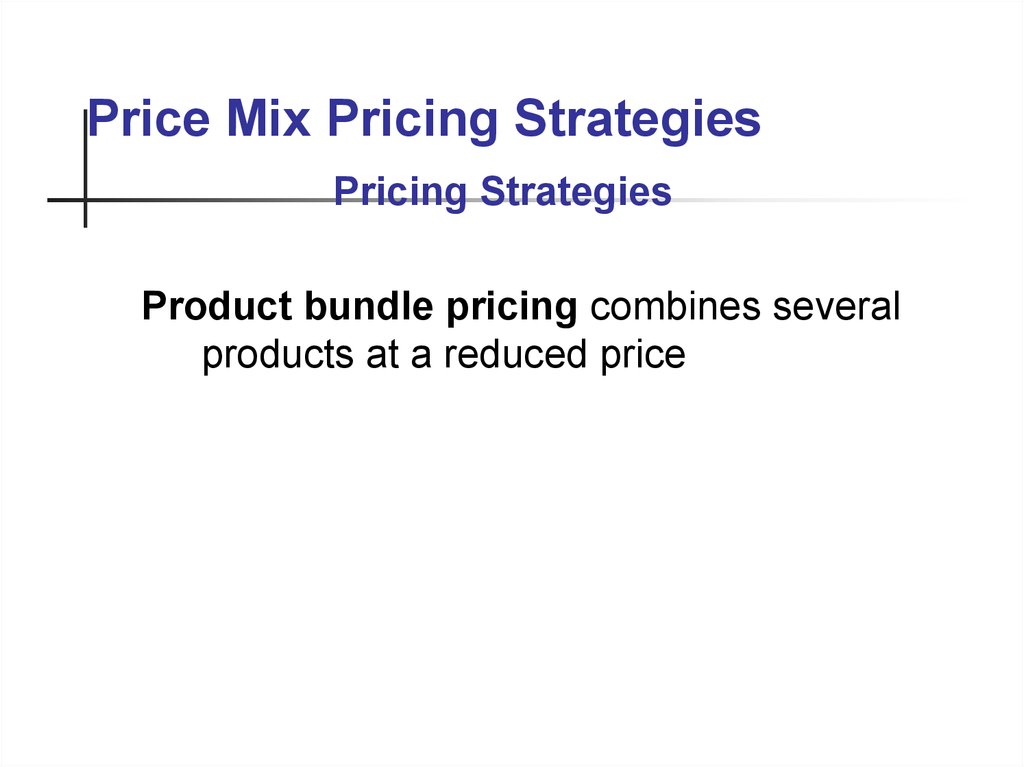

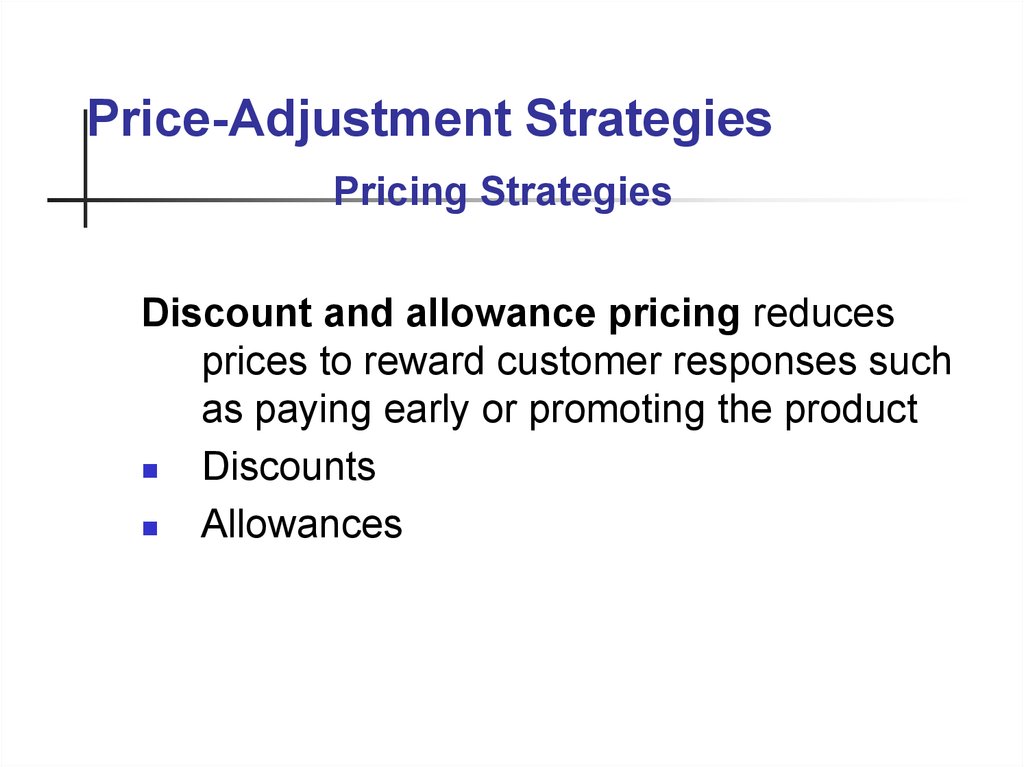





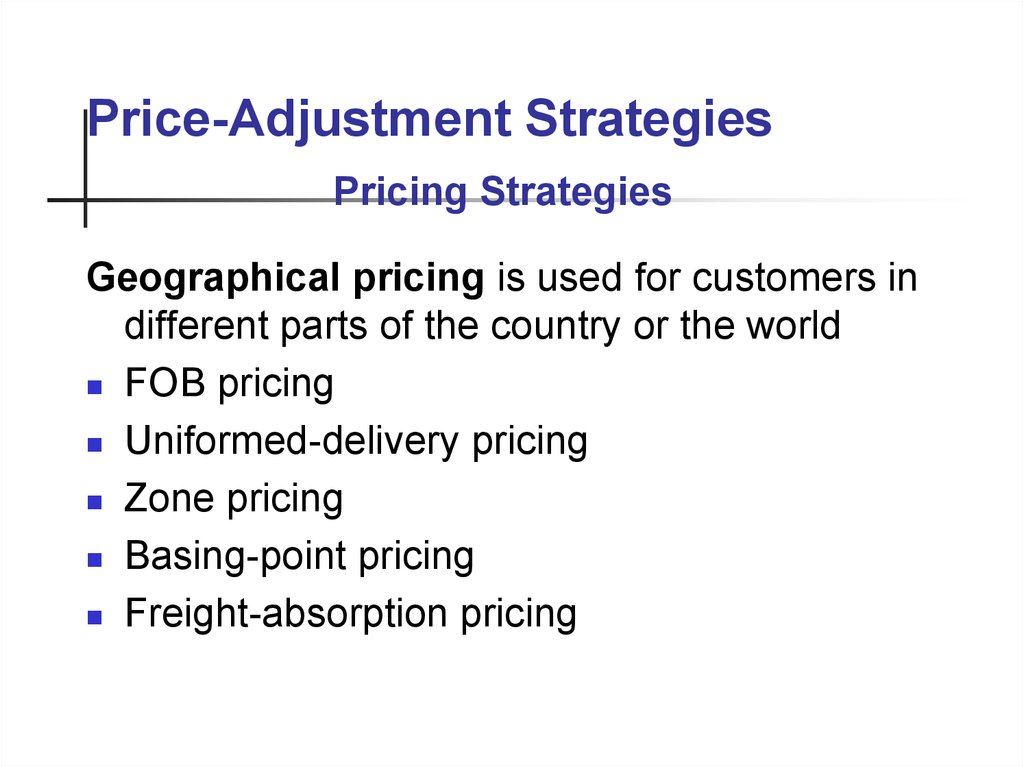
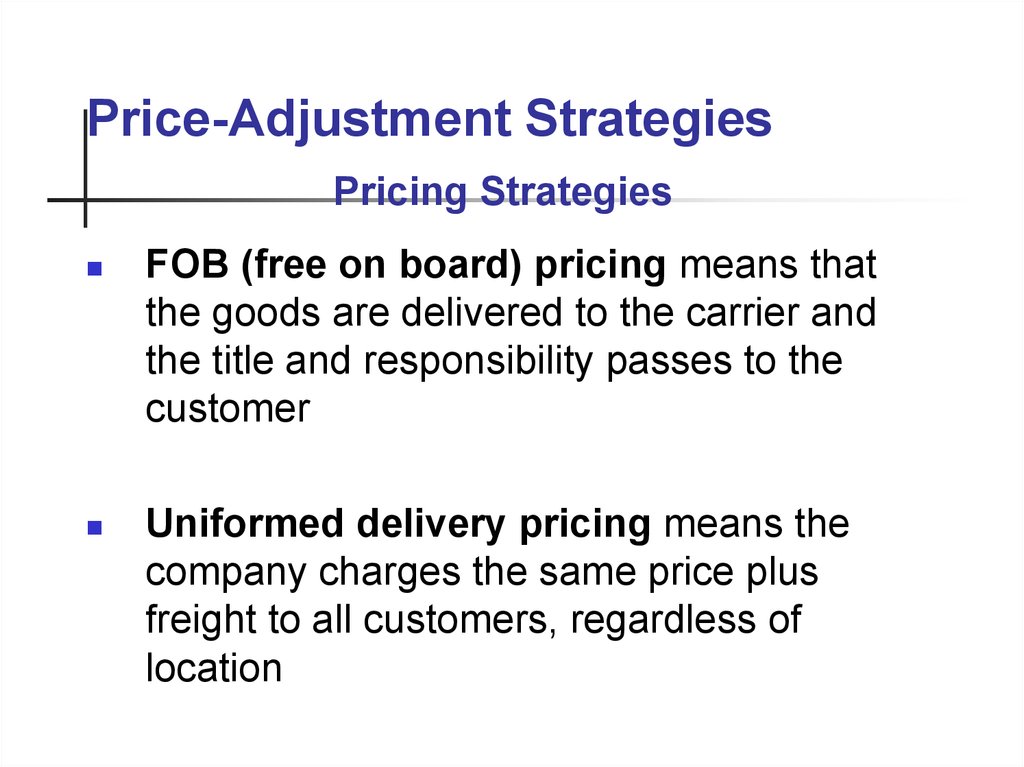

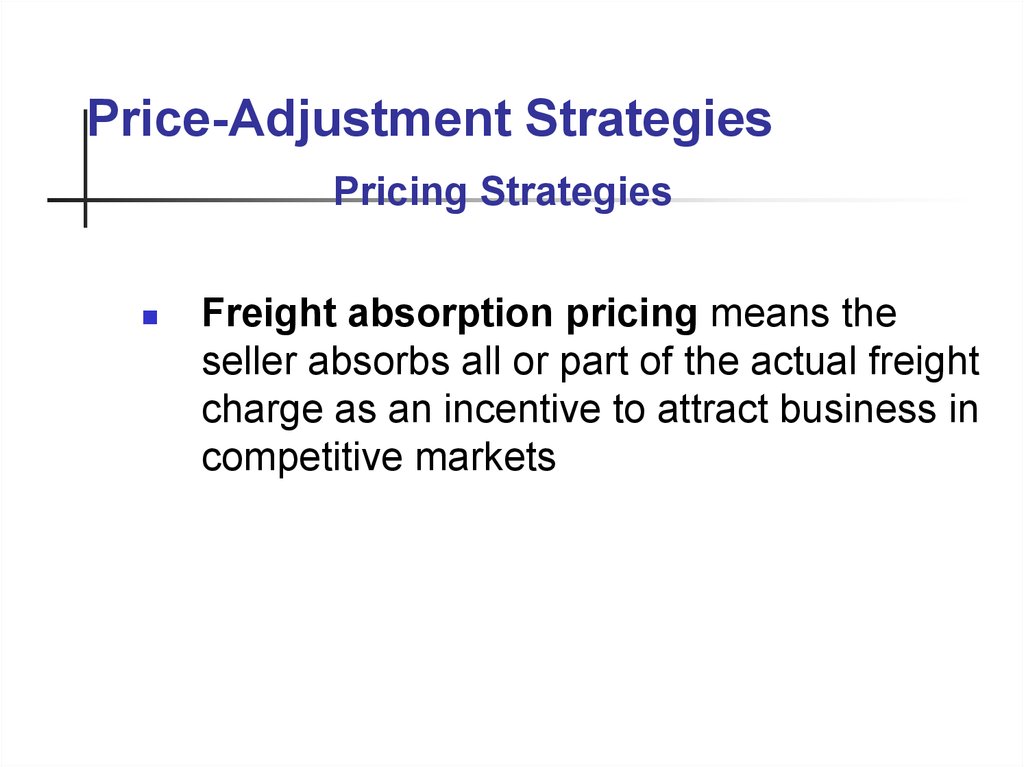



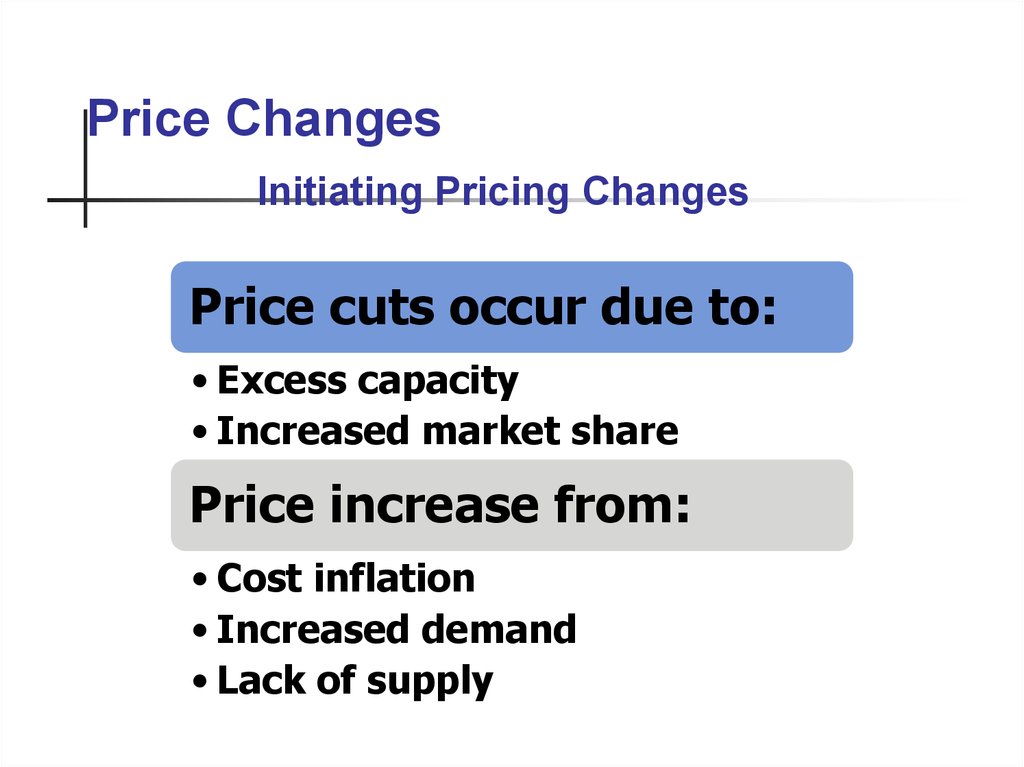
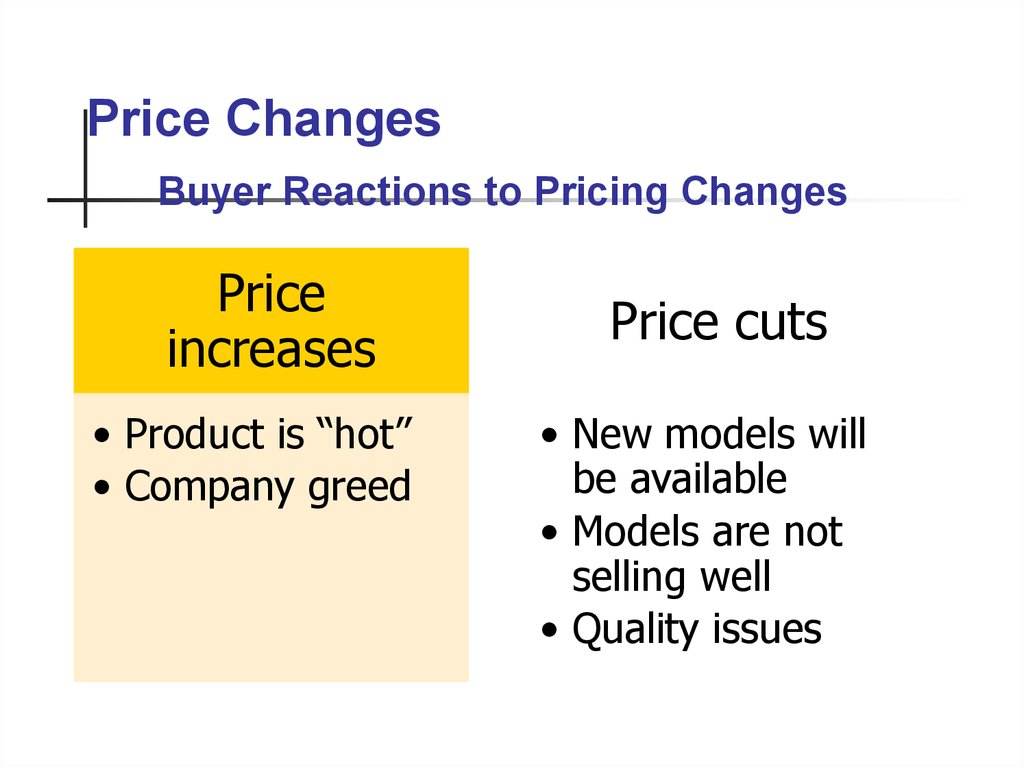
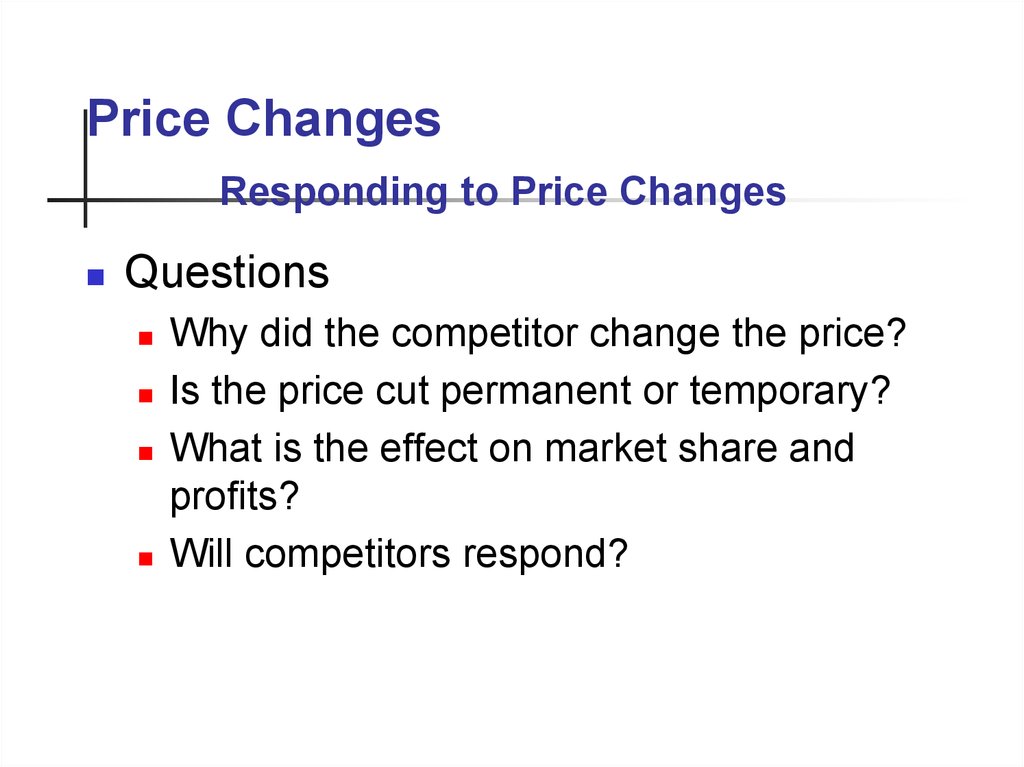

 Маркетинг
Маркетинг








